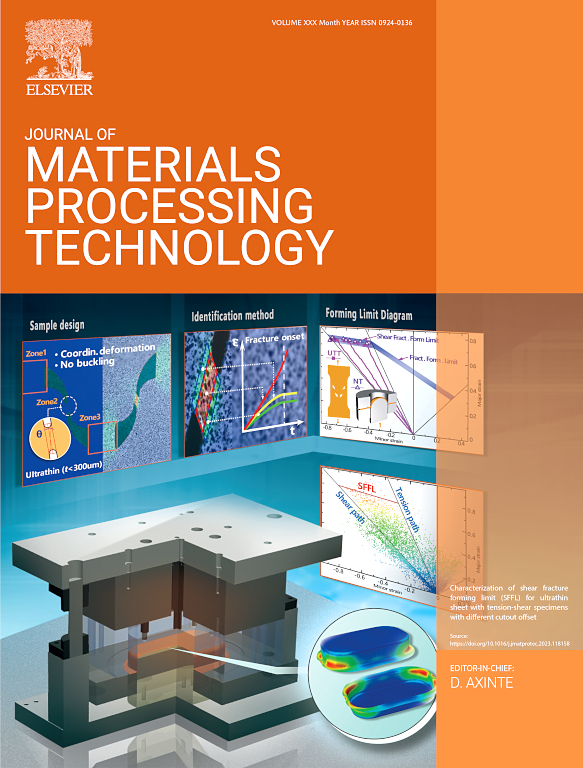基于人工神经网络的成形质量评价函数的多级拉深工艺优化设计
IF 7.5
2区 材料科学
Q1 ENGINEERING, INDUSTRIAL
Journal of Materials Processing Technology
Pub Date : 2025-05-02
DOI:10.1016/j.jmatprotec.2025.118881
引用次数: 0
摘要
由于材料、几何和接触非线性的积累,以及离散成形阶段和中间失效带来的复杂性,有效地实施多阶段拉深工艺具有挑战性。优化这一过程需要对离散成形阶段进行设计和集成,以建立优化的制造计划。本文提出了一种多阶段拉深推荐系统,该系统结合了一种新的成形质量评价函数,称为综合多阶段拉深评价函数(IMSDDEF)和非支配排序遗传算法III (NSGA-III)。该系统的目的是在考虑毛坯材料特性、靶网形状、产品质量和中间失效的情况下,以最少的成形阶段数提出接近最佳的成形方案。基于具有塑性各向异性的有限元模拟数据,开发了用于分类和回归的人工神经网络代理模型,并对其进行了训练,从而基于每个成形阶段的设计变量预测产品的可成形性、最小高度和厚度。IMSDDEF中基于流程图的决策逻辑集成了这些替代模型,以确定关键性能指标,包括适当的成形阶段数量、产品的形状损失和最小厚度。IMSDDEF与NSGA-III协调,在一分钟内得出帕累托最优解,实现冲突目标之间的权衡。从得到的帕累托锋面出发,通过详细的对比分析,选择最合适的成形方案。实验验证了该系统的可靠性和有效性。该新函数可以进一步推广到其他顺序材料加工优化场景,以优化多阶段拉深以外的制造计划。本文章由计算机程序翻译,如有差异,请以英文原文为准。
Optimum multistage deep drawing process design using artificial neural network-based forming quality evaluation function
Effectively implementing the multistage deep drawing process is challenging due to the accumulation of material, geometric, and contact nonlinearities, as well as the complexity introduced by discrete forming stages and intermediate failures. Optimizing this process requires the design and integration of discrete forming stages to establish an optimized manufacturing plan. This paper presents a multistage deep drawing recommendation system that combines a novel forming quality evaluation function, called the Integrated Multistage Deep Drawing Evaluation Function (IMSDDEF), with the Non-dominated Sorting Genetic Algorithm III (NSGA-III). The system aims to suggest near-optimal forming plans with a minimal number of forming stages, while accounting for blank material properties, target-net shape, product quality, and the intermediate failures. Artificial Neural Network surrogate models for classification and regression have been developed, trained on finite element simulation data with plastic anisotropy to predict product formability, minimum height, and thickness based on design variables at each forming stage. Flowchart-based decision-making logic in IMSDDEF integrates these surrogate models to determine key performance metrics, including the appropriate number of forming stages, as well as the product's shape loss and minimum thickness. IMSDDEF coordinates with NSGA-III to derive Pareto-optimal solutions within a minute, enabling trade-offs between conflicting objectives. From the resulting Pareto front, the most suitable forming plan is selected through detailed comparative analysis. Experimental validation is conducted to confirm the reliability and effectiveness of the proposed system. The novel function IMSDDEF could be further generalized to other sequential material processing optimization scenarios to optimize manufacturing plans beyond multistage deep drawing.
求助全文
通过发布文献求助,成功后即可免费获取论文全文。
去求助
来源期刊

Journal of Materials Processing Technology
工程技术-材料科学:综合
CiteScore
12.60
自引率
4.80%
发文量
403
审稿时长
29 days
期刊介绍:
The Journal of Materials Processing Technology covers the processing techniques used in manufacturing components from metals and other materials. The journal aims to publish full research papers of original, significant and rigorous work and so to contribute to increased production efficiency and improved component performance.
Areas of interest to the journal include:
• Casting, forming and machining
• Additive processing and joining technologies
• The evolution of material properties under the specific conditions met in manufacturing processes
• Surface engineering when it relates specifically to a manufacturing process
• Design and behavior of equipment and tools.
 求助内容:
求助内容: 应助结果提醒方式:
应助结果提醒方式:


